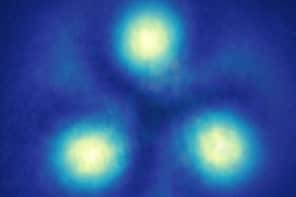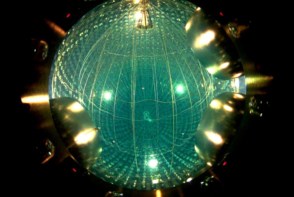
Scientists in France are the first to make a direct measurement of the Van der Waals force between two atoms. They did this by trapping two Rydberg atoms with a laser and then measuring the force as a function of the distance separating them. The two atoms were in a coherent quantum state and the researchers believe that their system could be used to create quantum logic gates or to perform quantum simulations of condensed-matter systems.
The Van der Waals force between atoms, molecules and surfaces is a part of everyday life in many different ways. Spiders and geckos rely on it to walk up smooth walls, for example, and the force causes proteins inside our bodies to fold into complicated shapes.
Named after the Dutch scientist Johannes Diderik van der Waals – who first proposed it in 1873 to explain the behaviour of gases – it is a very weak force that only becomes relevant when atoms and molecules are very close together. Fluctuations in the electronic cloud of an atom mean that it will have an instantaneous dipole moment. This can induce a dipole moment in a nearby atom, the result being an attractive dipole–dipole interaction.
Indirect measurements
There have been many indirect measurements of Van der Waals forces between atoms. Examples include analysing the net forces experienced by macroscopic bodies or using spectroscopy to work out the long-range behaviour of the force between two atoms in a diatomic molecule. However, a direct measurement has eluded scientists until now.
This latest research was done by researchers at the Laboratoire Charles Fabry (LCF) in Palaiseau and the University of Lille. “What we have done here, for the first time to our knowledge, is to measure directly the Van der Waals interaction between two single atoms that are located at a controlled distance, chosen by the experimenter,” says Thierry Lahaye, who is part of the LCF team.
Controlling the distance between normal atoms – while measuring the force between them – is extremely difficult because the relevant distances are tiny. To get round this problem the team used Rydberg atoms, which are much larger than normal atoms. Such atoms have one electron in a highly excited state. This means that they have a very large instantaneous dipole moment – and therefore should have very strong Van der Waals interactions over relatively long distances. They also have unique properties that allow them to be controlled with great precision in the lab.
Pairs of atoms
The experiment begins with two rubidium atoms trapped in two tightly focused laser beams separated by a few microns. Laser light at a specific wavelength is then shone on the atoms, which causes the system to oscillate between the ground state and one or two Rydberg atoms. The team found that when conditions were just right, the system oscillated between the ground state and a pair of Rydberg atoms, one at each laser focus. By measuring these oscillations, the team worked out the Van der Waals force between the two Rydberg atoms.
By adjusting the trapping laser beam, the team can move the Rydberg atoms closer together or further apart. As the researchers changed the distance R between the atoms, the force varied as 1/R6 – exactly as expected for the Van der Waals force.
In addition to the force measurement, the team was also able to show that the quantum evolution of the state of the two interacting Rydberg atoms was fully coherent – something that “has never been seen in atomic physics” claims LCF group member Antoine Browaeys.
Just like quantum logic
This coherent evolution of two interacting atoms is identical to that of a quantum-logic gate operating on two quantum bits (qubits). Browaeys believes that this suggests that two atoms interacting via Rydberg–Van der Waals interactions is a promising system for creating high-fidelity quantum gates. “The result is bringing us closer to a quantum computer,” he says.
Indeed, the scientists say that the long-term significance of their experiment is not the force measurement itself, but rather the high degree of control of the Rydberg atoms that they have achieved. “This will allow us to engineer small quantum systems of increasing size, from two to hopefully a few tens of Rydberg atoms, over which we have full control of the interactions,” explains Lahaye.
Such systems could find use in quantum information processing or the quantum simulation of condensed-matter systems such as quantum magnets.
Steven Rolston of the Joint Quantum Institute at the University of Maryland, who was not involved in the study, calls the work an important milestone towards creating quantum-information devices because it shows that the Van der Waals interaction between atomic qubits behaves as expected.
The experiment is described in Physical Review Letters.



